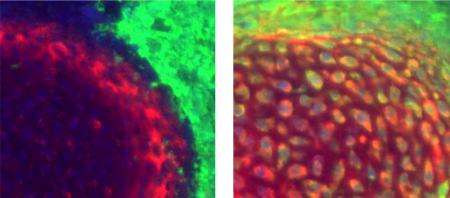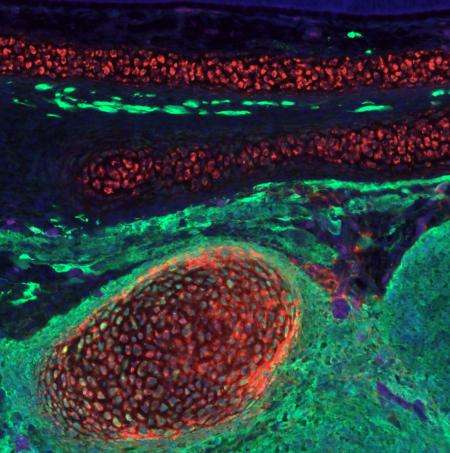Scientists transform lower-body cells into facial cartilage

Caltech scientists have converted cells of the lower-body region into facial tissue that makes cartilage, in new experiments using bird embryos. The researchers discovered a "gene circuit," composed of just three genes, that can alter the fate of cells destined for the lower bodies of birds, turning them instead into cells that produce cartilage and bones in the head.
The results, published in the June 24 issue of the journal Science, could eventually lead to therapies for conditions where facial bone or cartilage is lost. For example, cartilage destroyed in the nose due to cancer is particularly hard to replace. Understanding the genetic pathways that lead to the development of facial cartilage may help in future stem-cell therapies, where a patient's own skin cells could be transformed and used to repair the nose.
"When facial cartilage and bone is lost, from cancer or an accident, it has been difficult to replace," says Marianne Bronner, the Albert Billings Ruddock Professor of Biology at Caltech, and senior author of the Science report. "Our long term hope is that uncovering this gene circuit may be useful in reprogramming a patient's own stem cells to make facial cartilage."
The bones below our necks, referred to by scientists as the "long" bones, originate from a different source of tissue than the bones in our head. As embryos, we are born with a type of early tissue called the neural crest that forms along the entire body, from the head to the end of the spinal cord. Those neural crest cells which originate in the head, called cranial neural crest, differentiate into the cartilage and bone of our faces, including the jaws and skull. In contrast, the so-called trunk neural crest cells, forming below the neck, do not make cartilage or bone but instead turn into nerve cells and pigment cells elsewhere in our bodies. Bronner and her colleagues want to understand what genes regulate the development of cranial neural crest cells and enable them to make cartilage and bones in the head.

To this end, they divided the trunk and cranial neural crest cells of bird embryos into separate groups, and looked for differences in gene activity. Fifteen genes were initially identified as being turned on in only the cranial cells. The researchers chose six of these genes for further study. All six code for transcription factors—molecules that bind to DNA to turn on and off the expression of other genes. After studying how these factors interact with each other, the scientists focused on three, called Sox8, Tfap2b and Ets, that are part of the cranial neural crest circuit.
These three genes were then inserted into the bodies of developing bird embryos, in particular the trunk neural crest, using a technique called electroporation. In this method, electric current is applied to cells to open up pores through which molecules such as DNA may pass. Next, the researchers transplanted the altered trunk cells to the cranial region of the embryos. Five days later, the trunk cells were doing something entirely new: producing cartilage.
"Normally, these trunk cells will not make cartilage," says Bronner. "Introducing just three genes into these cells reprogrammed them to acquire the ability to do so."
Bronner said that she hopes other researchers will use this information for experiments in cell culture. By adding the new-found gene circuit, perhaps with other known factors, to skin cells in a petri dish it may be possible to turn them into cartilage-producing cells—a key next step in creating future therapies for facial bone and cartilage loss.
The first author of the Science paper, titled, "Reprogramming of avian neural crest axial identity and cell fate," is Marcos Simoes-Costa of Caltech.
More information: M. Simoes-Costa et al. Reprogramming of avian neural crest axial identity and cell fate, Science (2016). DOI: 10.1126/science.aaf2729



















